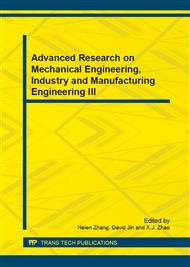[1]
Bedair O. Analysis and limit state design of stiffened plates and shell: a world view. ASME, (2009).
Google Scholar
[2]
Nicholas E D. Developments in the friction-stir welding of metals. ICAA-6: 6th International Conference on Aluminium Alloys, (1998).
Google Scholar
[3]
DebRoy T, Bhadeshia H K D H. Friction stir welding of dissimilar alloys–a perspective. Science and Technology of Welding and Joining, 2010, 15(4): 266-270.
DOI: 10.1179/174329310x12726496072400
Google Scholar
[4]
Taminger K M B, Hafley R A, and Dicus D L. Solid freeform fabrication: an enabling technology for future spacemissions. Keynote Lecture for 2002 International Conference on Metal Powder Deposition for RapidManufacturing. San Antonio, TX: Metal Powder Industries Federation, 2002: 51–56.
Google Scholar
[5]
Taminger K M B, Hafley R A. Electron beam freeform fabrication: a rapid metal deposition process. Proceedings of 3rd Annual Automotive Composites Conference. Troy, MI: Society of Plastic Engineers, (2003).
Google Scholar
[6]
Kapania R K, Li J, Kapoor H. Optimal design ofunitized panels with curvilinear stiffeners. AIAA 2005-7482, (2005).
DOI: 10.2514/6.2005-7482
Google Scholar
[7]
Joshi P, Mulani S B, Kapania R K. Optimal design of unitized structures with curvilinear stiffeners using response surface methodology. AIAA 2008-2304, (2008).
DOI: 10.2514/6.2008-2304
Google Scholar
[8]
Gurav S P, Kapania R K. Development of a framework for the design optimization of unitized structures. AIAA 2009-2186, (2009).
DOI: 10.2514/6.2009-2186
Google Scholar
[9]
Mulani S B, Locatelli D, Kapania R K. Algorithm development for optimization of arbitrary geometry panels using curvilinear stiffeners. AIAA 2010-2674, (2010).
DOI: 10.2514/6.2010-2674
Google Scholar
[10]
Joshi P, Mulani S B, Gurav S P, et al. Design optimization for minimum sound radiation from point-excited curvilinearly stiffened panel. Journal of Aircraft, 2010; 47(4): 1100-1110.
DOI: 10.2514/1.44778
Google Scholar
[11]
Mulani S B, Slemp W C H, Kapania R K. EBF3PanelOpt: a framework for curvilinear stiffened panels optimization under multiple load cases. AIAA 2010-9238, (2010).
DOI: 10.2514/6.2010-9238
Google Scholar
[12]
Dang T D, Kapania R K, Slemp W C H, et al. Optimization and postbuckling analysis of curvilinear-stiffened panels under multiple-load cases. Journal of Aircraft, 2010; 47(5): 1665-1671.
DOI: 10.2514/1.c000249
Google Scholar
[13]
Mulani S B, Locatelli D, Kapania R K. Grid-stiffened panel optimization using curvilinear stiffeners. AIAA 2011-1895, (2011).
DOI: 10.2514/6.2011-1895
Google Scholar
[14]
Mulani S B, Duggirala V, Kapania R K. Curvilinearly T-stiffened panel optimization framework under multiple load cases using parallel processing. AIAA 2012-1754, (2012).
DOI: 10.2514/6.2012-1754
Google Scholar
[15]
Bushnell D. PANDA2—Program for minimum weight design of stiffened, composite, locally buckled panels. Computers and Structures 1987; 25(4): 469-605.
DOI: 10.1016/0045-7949(87)90267-7
Google Scholar
[16]
Bushnell D. Recent enhancements to PANDA2. Proceedings of the 37h AIAA/ASME/ASCE/AHS/ASC Structures, Structural Dynamics and Materials Conference, AIAA Paper 96-1337, Salt Lake City, UT, April (1996).
DOI: 10.2514/6.1998-1990
Google Scholar
[17]
Bushnell D. Additional buckling solutions in PANDA2. Proceedings of the 40th AIAA/ASME/ASCE/AHS/ASC Structures, Structural Dynamics and Materials Conference, AIAA Paper 99-1233, St. Louis, Missouri, April 1999; 302-345.
DOI: 10.2514/6.1998-1990
Google Scholar
[18]
Kim G I, Tuttle M E. Buckling analysis for a stiffened panel. Proceedings of the 40th AIAA/ASME/ASCE/AHS/ASC Structures, Structural Dynamics and Materials Conference, AIAA Paper 94-1496, Hilton Head, SC, April 1994; 1423-1433.
DOI: 10.2514/6.2007-2126
Google Scholar
[19]
Deb K, Pratap A, Agrawal S, et al. Fast and elitist multiobjective genetic algorithm: NSGA-II. IEEE Transactions on Evolutionary Computation, 2002, 6(2): 182–197.
DOI: 10.1109/4235.996017
Google Scholar
[20]
Yusoff Y, Ngadiman M S, Zain A M. Overview of NSGA-II for optimizing machining process parameters. Procedia Engineering, 2011, 15: 3978-3983.
DOI: 10.1016/j.proeng.2011.08.745
Google Scholar


